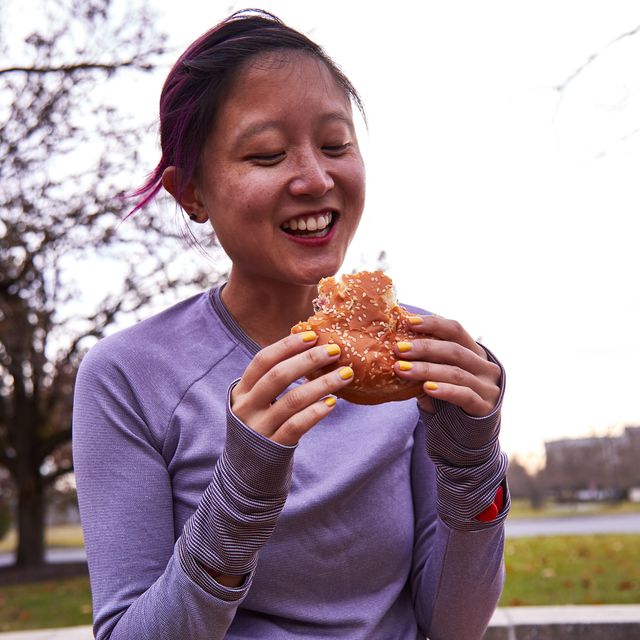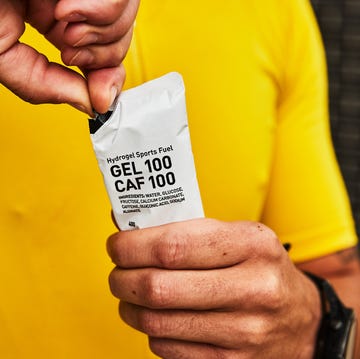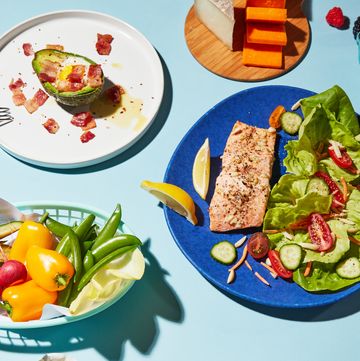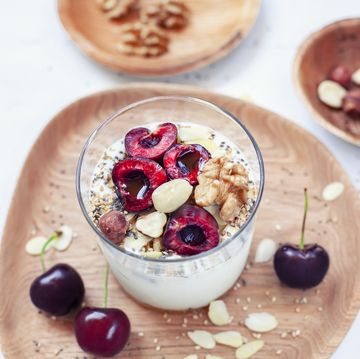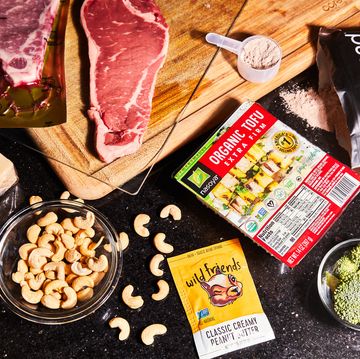As you ramp up run training in prep for marathon season, you may assume your appetite will follow a similar upward trajectory. But that’s not always the case.
On the contrary: Intense or prolonged exercise can actually suppress hunger, quashing your desire to eat, Jordan Hill, RD, a Colorado-based registered dietitian and certified specialist in sports dietetics with Top Nutrition Coaching, tells Runner’s World.
Combine that with other factors—including lack of awareness about what and how much your body needs to sustain training, not having enough time to meal prep, and fear of weight gain—and it’s no surprise that many endurance runners are under-fueled.
Research confirms the struggle: A 2021 study of 207 cross-country runners, for example, found that 79.5 percent of female athletes and and 54 percent of male athletes were at risk of low energy availability (not intaking enough calories to support their workouts and daily needs).
That’s a problem, since subpar nutrition can trigger a cascade of issues that negatively affect your workouts—and overall health.
Here, with the help of two registered dietitians, we explain why eating enough calories is crucial to both your run performance and day-to-day functioning, telltale signs you’re underfueling, and easy ways to rev your appetite to help meet your caloric needs.
Why Adequate Calorie Intake is So Crucial for Runners
Calories are synonymous with energy, Hill explains, so not getting enough calories means you’re not getting enough energy for your body. That deficit can influence pretty much every bodily function including your immune system and metabolism, heart, hormones, GI system, and even mental health, she explains.
More specifically, not getting enough calories can decrease your performance in workouts, lead to excessive fatigue, increased your risk for injury and illness, cause nutritional deficiencies, decrease muscle mass, trigger hormonal imbalances, and cause negative psychological effects, such as mood swings, difficulty concentrating, and increased stress levels, says Hill. In other words, when you don’t fuel enough your body and mind take a serious hit.
Additionally, if you continually eat less than your body needs, you risk suppressing your appetite overall, Amity Lui, MS, RD, a New York City-based sports dietitian who works with runners, tells Runner’s World. “Not eating enough will actually impact your body’s metabolic rate and cause your body to kick into survival mode,” she adds. This means your body will require less calories over time and will shut down certain functions to save energy while increasing storage of body fat, according to Lui.
In some cases, underfueling can lead to relative energy deficiency in sport (RED-S) syndrome–essentially, a chronic state of low energy availability, Lui explains. Unfortunately, RED-S can cause long-lasting, negative effects, including decreased bone density, chronic fatigue, poor recovery, and diminished enjoyment of running since “you literally have no energy for it,” says Lui.
On the flip side, amping up calorie intake to meet your needs “will reap almost immediate benefits,” says Lui. These include increased energy, mood, cognition, and run performance, she says. You’ll also benefit from enhanced recovery, a strengthened immune system, improved body composition and cardiovascular health, elevated psychological well being, reduced risk for nutritional deficiencies, and improved hormonal balance, says Hill.
Signs of Underfueling
There are a number of signs you’re not eating enough to support your training, and tuning into them can help you rev up your nutrition habits before longer-term problems arise. “If athletes cue into how they’re feeling and what their body is doing, they can usually pick up on not eating enough before RED-S would become an issue,” says Hill.
Common signs of underfueling, according to Lui and Hill, include:
- Decreased energy levels and feelings of abnormal fatigue—think: needing long naps every day, going to bed earlier than usual, or saying no to plans because of fatigue
- Decreased performance in workouts—this could include being unable to complete your workouts, or consistently not reaching your target paces
- Psychological and emotional changes—examples: mood swings, slowed cognition, irritability, lack of concentration, and generally feeling unmotivated
- Prolonged muscle soreness and slow recovery
- Getting sick or injured more often
- Unintentional weight loss or difficulty maintaining your current weight
- Hormonal disruptions, including loss of menstrual cycle
- Changes in sleep patterns
- Always feeling cold
- Hair loss
12 Ways to Increase Appetite
A big reason runners struggle to get in all the calories they need is they simply don’t feel hungry.
Now, there are a “bunch of ways that our body tells us we’re hungry,” says Hill. You may not always hear your stomach growl, but could instead experience hunger in the form of a headache or fatigue. “It’s important for each person to figure out what’s their individual cue for hunger to help them be aware of that,” says Hill.
With that in mind, here are 12 expert-backed ways to kickstart your appetite and thus up your chances of eating enough calories.
1. Eat breakfast
A lot of Lui’s clients report having just coffee as their breakfast, and that’s a no-no. Skipping meals can lead to prolonged hunger, which can suppress your appetite in the long-term. “It’s almost like ignoring your body’s hunger cues,” Lui explains. “If you keep ignoring something, your body will no longer register it as a sign that you need food.”
Additionally, forgoing the first meal of the day may make it more difficult to achieve your overall calorie totals for the day. Plus, dodging a.m. fuel is associated with nutrient deficiencies and poor diet quality, according to other research.
Not sure what to chow on? Check out these on-the-go breakfast ideas for runners, plan your breakfast in advance with some meal prepping, or whip up one of these recipes to fuel your morning runs.
2. Consume smaller, more frequent meals
Instead of cramming all your calories into three big meals—which can be daunting if you’re just not feeling hungry—opt for smaller, more frequent feeding sessions. There’s no perfect cadence, but as a general rule of thumb, aim to nosh every two to three hours, suggests Hill. “It doesn’t have to be full-on meals,” she warns. Nutrient-dense snacks can fit the bill, too (more on that below).
3. Reach for easy-to-digest fuel post workout
The most common time Hill sees athletes struggle with low appetite is right after a training session, since, like we mentioned, prolonged or intense training can suppress hunger. But getting fuel in anyways—ideally within 30 minutes of a workout—is an important part of the recovery process and can, in many cases, help kickstart your appetite, says Hill.
Postrun, she recommends reaching for refreshing, easily digestible snacks, like a fruit smoothie, because they’ll be easier to stomach—literally. Lui, for her part, is a big fan of recovery shakes that have a three-to-one ratio of carbs to protein for optimal refueling.
4. Opt for energy-dense bites
If you’re really struggling to feel hungry, but know it’s time to intake calories, pick higher-calorie, higher-nutrient snacks to maximize the fuel you’re consuming, says Hill. So instead of having just a plate of crackers, have crackers with cheese and deli meat or nut butter, she says. Or in lieu of popcorn alone, combine popcorn with jerky or popcorn and nuts. Other options include Greek yogurt with granola, fruit, chia, or flax seeds; toast with nut butter; or hummus and veggies. The goal, says Hill, is to pair more than one macronutrient together.
5. Stay hydrated
Dehydration can screw with your appetite, says Hill, so it’s important to stay on top of your intake. Hydration needs vary and depend on factors including how much you exercise and sweat, your overall health, and the heat, humidity, and elevation of your environment, per the Mayo Clinic. As a general rule of thumb, you’re probably adequately hydrated if you don’t feel thirsty and your pee is light yellow or colorless.
6. Consider liquid calories
When hunger just isn’t there, it’s often easier to drink versus chew your calories. That’s where things like smoothies, shakes, juices, and soups can be helpful. “It is less taxing to sip on something versus having to prepare, reheat the food, cook it, and then chew it,” says Lui. To make your sippable meals as nutritious as possible, consider adding nutrient-dense extras like nut butters and seeds, she says.
7. Find foods you actually enjoy
This may sound like a no-brainer but finding foods you actually enjoy eating—and not focusing so much on what you feel like you should be eating—can help combat a suppressed appetite, says Lui. After all, you’re much more likely to want to nibble when it’s something you genuinely like versus something you feel obligated to choke down.
8. Reduce fiber intake
High-fiber foods can help keep you ~regular~ but they also keep you feeling full for longer, which may not be desired when you’re struggling with appetite. Fiber-rich meals, like large salads, “can result in bloating and delay gastric emptying, both of which can make you feel less hungry,” explains Lui. So, instead of opting for a kale salad at lunch, consider a grain bowl with quinoa, farro, rice, or barely; in lieu of a whole baked potato at dinner, have a bowl of pasta.
9. Keep mealtime exciting
Hill explains it this way: “If you’re eating the same thing over and over, you’re already going to be disinterested, and then you throw no appetite on top of that, and it’s really going to make you not want to eat.”
Beat the mealtime blahs by trying new-to-you flavors and textures. Make a reservation at that just-opened restaurant in town. Or, explore food blogs, watch cooking shows, and follow social media accounts that offer diverse and innovative recipes, suggests Hill.
10. Pack snacks
To help with eating consistently, carry non-perishable snacks with you—like granola bars or trail mix—so that you’ll have something to nosh on during those times when you’re commuting and transportation gets held up or you end up having to run an extra errand. “I like to call them emergency snacks, even though sometimes I eat them not in an emergency,” says Lui.
11. Cook with oils
Don’t be afraid to cook with oils, says Lui. This will allow you to get more calories in without having to eat a higher volume of grub. Plus, the fats in the oil enhance the absorption of fat-soluble vitamins, including vitamins A, D, E, and K, Lui adds. So instead of boiling or steaming your veggies, for example, coat them in oil and grill, stir fry, air fry, or sauté them.
12. Tap an expert for help
Because dietary needs and the factors affecting your appetite can be so individualized, it never hurts to consult a registered sports dietitian for personalized advice. They can help you figure out where you can incorporate more nutrient- and energy-dense meals and snacks into your day, says Lui, as well as determine how you can best fuel for your training goals.

Jenny is a Boulder, Colorado-based health and fitness journalist. She’s been freelancing for Runner’s World since 2015 and especially loves to write human interest profiles, in-depth service pieces and stories that explore the intersection of exercise and mental health. Her work has also been published by SELF, Men’s Journal, and Condé Nast Traveler, among other outlets. When she’s not running or writing, Jenny enjoys coaching youth swimming, rereading Harry Potter, and buying too many houseplants.
